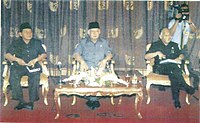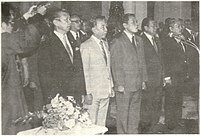Harmoko
Harmoko | |
|---|---|
 Harmoko in 1997 | |
| Information Minister of Indonesia | |
| In office 1983–1997 | |
| Preceded by | Ali Murtopo |
| Succeeded by | Alwi Dahlan |
| Leader of Golkar | |
| In office 1993–1998 | |
| Preceded by | Wahono |
| Succeeded by | Akbar Tanjung |
| 12th Speaker of the People's Representative Council | |
| In office 1997–1999 | |
| Preceded by | Wahono |
| Succeeded by | Akbar Tanjung |
| Personal details | |
| Born | 7 February 1939 Kertosono, Residency of Kediri, East Java, Dutch East Indies |
| Died | 4 July 2021 (aged 82) Jakarta, Indonesia |
| Nationality | Indonesian |
| Political party | Golkar |
| Spouse(s) | Sri Romadhiyati |
Harmoko (7 February 1939 – 4 July 2021) was an Indonesian politician who served as Minister of Information from 1983 to 1997 and as chairman of both the People's Consultative Assembly and the People's Representative Council between 1997 and 1999, during the fall of Suharto.
Early career[]
After attending journalism school in Jakarta, Harmoko began working as a journalist with Merdeka weekly news magazine in 1960.[1] He worked on a number of newspapers, and in 1970 became editor of the Pos Kota[1] and Terbit Jakarta dailies. In 1975, he became a member of the Press Council and of the Film Censorship Board.[2]
Political career[]
In 1977, Harmoko became a member of the Indonesian legislature, the People's Consultative Assembly.[3] He served as information minister in the New Order regime of President Suharto in three successive cabinets (Fourth Development Cabinet, Fifth Development Cabinet and Sixth Development Cabinet) from 1983 until 1997,[2] during which time it was said that his name was an abbreviation for hari-hari omong kosong (talking nonsense every day).[4] Harmoko used his authority to extend the remit of the press publication enterprise permit (SIUPP). Withdrawal of the SIUPP from a publishing company meant it could no longer legally function, and it could also be used to effectively ban individual publications. After the weekly news magazine Tempo published an article critical of the purchase of 39 East German warships by Research and Technology Minister B. J. Habibie, the magazine's SIUPP was revoked on 21 June 1994 and it ceased publishing. Two other news publications, Detik and Editor, were banned at the same time.[5]
Following a term as deputy chairman, Harmoko was chairman of the Golkar ruling political organization from 1993 to 1998, becoming the first civilian to hold this position.[6] In June 1997, he was appointed state minister for special affairs, a post he held for only three months as in October 1997, he was chosen as chairman of the People's Consultative Assembly and People's Representative Council, a post he held until 1999.[7] Despite years of loyalty to President Suharto, following widespread student demonstrations calling for a change of government, on 18 May 1998, Harmoko caused great surprise at a press conference by asking the president to step down within five days. This may have been because Harmoko was upset by his dismissal as information minister and his not being considered for the vice-presidency, or possibly because Harmoko was upset after rioters set fire to his house in Surakarta.[8][9]
Suharto saw Harmoko's request as a betrayal, and when Harmoko attempted to visit Suharto on his deathbed in 2008, he was refused.[10] Tadjus Sobirin, Golkar's Jakarta chairman in 1998, called Harmoko "Brutus" during a leadership meeting of the party.[11]

Harmoko (left) sitting alongside President Suharto and Vice President B. J. Habibie.

Harmoko (fourth from left) being sworn in as a functionary of the General Elections Institution.
Death[]
Harmoko died on 4 July 2021 at the Gatot Soebroto Army Hospital due to COVID-19,[12][13] and was buried the following day at Kalibata Heroes Cemetery.[14] He had previously suffered from motor neuropathy since 2016, restricting him to a wheelchair, and was treated for a lung infection in 2018.[15]
Honours[]
Foreign honours[]
 Malaysia: Honorary Commander of the Order of Loyalty to the Crown of Malaysia (P.S.M.) (1998)[16]
Malaysia: Honorary Commander of the Order of Loyalty to the Crown of Malaysia (P.S.M.) (1998)[16]
Citations[]
- ^ Jump up to: a b Sekretariat Jenderal DPR RI 1999, pp. 147–148.
- ^ Jump up to: a b The Editors 1993, p. 170.
- ^ Sekretariat Jenderal DPR RI 1999, p. 148-149.
- ^ Salim 2015.
- ^ Rogers 2014.
- ^ Schwarz 1999, pp. 418, 478.
- ^ Sekretariat Jenderal DPR RI 1999, pp. 143–151.
- ^ Friend 2003, p. 341.
- ^ Schwarz 1999, pp. 620, 845.
- ^ "Akhirnya Ungkap Bukti Rahasia". detiknews (in Indonesian). 21 May 2008. Retrieved 24 January 2021.
- ^ Novianto, Kholid (2004). Akbar Tandjung dan Partai Golkar era reformasi (in Indonesian). Sejati-Press. p. 32. ISBN 978-979-99100-0-4.
- ^ detikcom, Tim. "Harmoko, Menteri Penerangan Era Soeharto Meninggal Dunia". detiknews (in Indonesian). Retrieved 6 July 2021.
- ^ "Sang Putra Akui Hasil Tes PCR Terakhir Harmoko Positif Covid-19". Tribunnews.com (in Indonesian). Retrieved 6 July 2021.
- ^ "Harmoko Akan Dimakamkan di Taman Makam Pahlawan Kalibata". KOMPAS.com (in Indonesian). 5 July 2021. Retrieved 5 July 2021.
- ^ "Harmoko Tangan Kanan Soeharto Sudah Berkursi Roda Saat Melayat BJ Habibie, Sejak 2016 Kesehatannya Menurun dan Sulit Komunikasi". gridhealth.id (in Indonesian). 13 September 2019. Retrieved 5 July 2021.
- ^ "Semakan Penerima Darjah Kebesaran, Bintang dan Pingat".
General references[]
- The Editors (April 1993). "The Sixth Development Cabinet Announced March 17, 1993" (PDF). Indonesia. 55 (55): 167–176. doi:10.2307/3351095. hdl:1813/54004. JSTOR 3351095. Retrieved 16 May 2020.
- Friend, Theodore (2003). Indonesian destinies. Cambridge, Massachusetts: Belknap Press of Harvard University Press. ISBN 0-674-01137-6.
- Rogers, Cory (26 June 2014), "Twenty years after 'Tempo' banning reflection", The Jakarta Post, retrieved 18 May 2020
- Salim, Zaid (12 September 2015), "The abuse of verbal culture", The Jakarta Post, retrieved 17 May 2020
- Schwarz, Adam (1999). A Nation in Waiting: Indonesia's Search for Stability (2nd ed.). Allen & Unwin. ISBN 9781760636913.
- Sekretariat Jenderal DPR RI (1999), Profil Ketua-ketua DPR RI sejak tahun 1945 s/d Agustus 1999 [Profiles of the Speakers of the People's Representative Council of the Republic of Indonesia from 1945 to August 1999] (PDF) (in Indonesian), Jakarta: Sekretariat Jenderal DPR RI
- Simanjuntak, P. N. H. (2003). Kabinet-Kabinet Republik Indonesia: Dari Awal Kemerdekaan Sampai Reformasi [Cabinets of the Republic of Indonesia: From the Beginning of Independence to the Reform Era] (in Indonesian). Jakarta: Djambatan. ISBN 979-428-499-8.
- Speakers of the People's Consultative Assembly
- 1939 births
- 2021 deaths
- Indonesian Muslims
- People from Nganjuk Regency
- Golkar politicians
- Honorary Commanders of the Order of Loyalty to the Crown of Malaysia
- Speakers of the People's Representative Council
- Deaths from the COVID-19 pandemic in Indonesia

